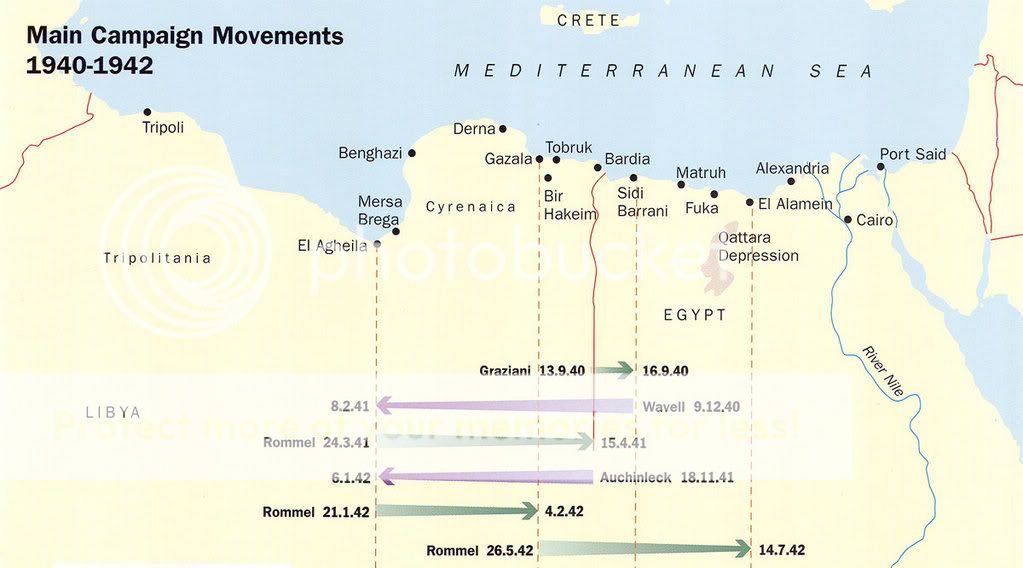A Very Brief Overview of the North African Campaign
 |
| A pretty good diagram of all the offensives made in the desert campaign. The only one missing is Montgomery's offensive in October 1942 at Alamein which resulted in the capture of Tripoli in January 1943 and the link up with the Allied army in Tunisia. |
As part of the preparation for our first Desert Operational Game on 25th June I thought it would be useful to introduce the period, terrain, armies and rules over the next few weeks. I read through Ozzy's copy of Flames of War and was inspired by the concise history of the WW2 campaigns in their rule book to do a version of my own. So, here goes.....
There were three main combatants, all with their own strategic objectives.
The British Empire and Commonwealth.
The Mediterranean was the main strategic highway for the British Empire, connecting the industrial homeland via the Suez Canal to markets and possessions in India, the Far East and Australasia. Oil supplies were important from the Middle East but not as vital as those that came from the Caribbean and Venezuela. However, these oil supplies would have been of immense importance to the Axis powers and the capture of Egypt and the Middle East could have outflanked the Russian front and brought Turkey into the war on the Axis side. In addition, after the retreat from Dunkirk, this was the only theatre in which the British army faced the Axis powers; for Churchill success in the desert was vital to British prestige and morale.
Italy
Mussolini saw the Mediterranean area as Italy's sphere of influence. Domination of this geopolitical area would elevate his fascist empire to great power status. Germany's defeat of France had removed one rival, only Britain stood in his way.
Germany
Hitler and the army did not see the Mediterranean as vital to winning the war. However, Hitler could not afford to let his only ally and fellow dictator be defeated by Britain and was prepared to prop up the Italians by sending Rommel and the Afrika Korp. Strategically, the Mediterranean was a buffer zone protecting the southern flank of his attack on Russia from British intervention.
The Theatre of Operations
So as you can see, all three participants had very different interests at stake in the desert which influenced the forces involved and the support that would be sent. The area involved was barren, with no natural resources, few civilians and very little infrastructure; set against the technology of the 1940s they may as well have been fighting on an alien planet.
Britain had the most tenuous lines of supply as Axis airfields in Italy, Sicily and Crete dominated the Mediterranean, and therefore had to send ships via Cape Town or aircraft through the centre of Africa. However, the Royal Navy and its large merchant marine enabled these lines of supply to be maintained and the United States was very active in its support even before entering the war.
The Axis powers had the shortest lines of supply, but British bases in Gibraltar, Alexandria and especially Malta made these short routes across the Mediterranean very dangerous. In addition, oil was supplied from Rumania and the Italian merchant marine was even under attack by the Russians in the Black sea.
All offensives were thus reliant on shipments of supplies. Whoever built up the most first, launched an attack which coincides with the dates on the map above. However, these attacks would fizzle out once the supply lines through the desert got too long and your enemy was pushed back closer to their base points. Thus, many historians refer to a pendulum effect as the fighting ebbed and flowed across the desert.
The British base in Alexandria, Egypt was 1892 kms from the main Axis base at Tripoli in Libya. Benghazi and Tobruk were the only half decent port facilities between these two points. The Italians never had the industrial resources to enable them to supply a large enough mechanised army in this terrain. Rommel came close to achieving a success in the summer of 1942 through tactical genius and captured supplies. Montgomery is often criticised for his cautious and deliberate offensives but he was the only desert commander to maintain an advance with stretched supply lines over the full 1892 kms in just over two months!
1 comment:
Good overview Ian. Looking forward to this.
Post a Comment